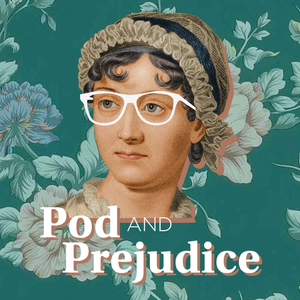
Walled Up Alive
01/17/20 • 43 min
Walling up a living victim, or immurement, has been used both as a punishment and for darker, magical purposes. In this episode, we detangle the history from the folklore of this grisly act.
We begin with an instance of immurement from Edgar Allan Poe’s 1846 story “The Cask of Amontillado” (including a clip from a dramatization in 1954 radio show, Hall of Fantasy) and also get a glimpse of director Roger Corman’s freewheeling use of this element from Poe his 1962 anthology film, Tales of Terror, as well as 1961’s The Pit and the Pendulum.
Peter Lorre walls up Vincent Price in Roger Corman’s Tales of Terror (1962)Poe’s interest in immurement is typical of Gothic writers and their fascination with crypt-like spaces, often including the cells and catacombs within Catholic churches and monastic communities. Tales of immured nuns, abbots, and abbesses are particularly common, with the deed understood most typically as a punishment for unchastity but also occasionally for other outrageous deeds or teachings (including a case of dabbling in the black arts). We have a look at some cases in which actual immured skeletons were said to have been discovered in religious communities and then consider the lore explaining their presence. We also look at ways in which writers like Sir Walter Scott and H. Rider Haggard blurred the line between historical and literary stories.
An 1895 booklet debating the topic of “Walled up Nuns & Nuns Walled In”It’s likely that tales of nuns immured for unchastity were particularly prevalent as they echo the fate of Rome’s Vestal Virgins who failed to protect their virginity. We hear some details of immurements, not only from ancient Rome, but also Greece as well as a particularly gruesome account read by Mrs. Karswell describing an ancient Assyrian revenge spree featuring immurement.
“The Death of Cornelia, Vestal Virgin” by G. Mochetti.Medieval accounts of immurement we look at include the Christian legend of The Seven Sleepers of Ephesus and one recounted in Dante’s Divine Comedy, that of Count Ugolino della Gherardesca of Pisa (and his children/grandchildren, who are involved in a particularly grisly way).
Our next segment looks at punitive immurement from a cluster of legends in Scandinavia and the Baltic states. We begin with a story from the Swedish island of Gotland, that of the Jungfrutornet (“maiden’s tower”) in the town of Visby. The tower’s name is taken from the story of a maiden, who falls in love with a spy from Denmark, who uses her to obtain keys to the city gate in preparation for a devastating invasion. The maiden’s punishment for betraying her town is, as you would have guessed, immurement.
We hear a similar story from Finland, which serves as the basis of the song (from which we hear a clip) Balladi Olavinlinnasta or the ballad of Olaf’s Castle, and also a tale from a castle in Haapsalu, Estonia, said to be haunted by the maiden immured there. Then we look at a church in the Estonian town of Põlva, where a particularly devout maiden was said to have allowed herself to be interred in a position of kneeling devotion as a sort of religious talisman forever protecting the church.
Sculpture of the walled in wife Rozafa, an Albanian version of the stonemason legend.This notion of self-sacrificing immurement in a Christian context figures into the bizarre legend recounted of the 6th-century Irish saint Columba and his companion Odran, who allowed himself to be entombed in the foundation of a church on the Scottish island of Iona.
Our last segment looks at further stories of living humans entombed in buildings and other structures in what’s called a “foundation sacrifice.” A cluster of tragic legends and ballads from southeastern Europe tell similar stories of women immured in structures by their husbands who work as stonemasons. We hear these tales illustrated by a clip from the Hungarian ballad Kőműves Kelemen (“Kelemen the Stonemason”) as well as a bit of the soundtrack from the 1985 film The Legend of Suram Fortress by Sergei Parajanov — it’s based on a Georgian folk tale, so geographically close, though not quite one of the stonemasons-who-wall-up-their-wives genre. But it’s a lovely film I just wanted to include.
We then move west in Europe to hear some stories of foundation sacrifices collected largely in Germany. These include ancient sacrifices of children to the security of city walls, castles, and bridges, including a panic around a child sacrifice presumed necessary to a railroad bridge constructed near the tow...
Walling up a living victim, or immurement, has been used both as a punishment and for darker, magical purposes. In this episode, we detangle the history from the folklore of this grisly act.
We begin with an instance of immurement from Edgar Allan Poe’s 1846 story “The Cask of Amontillado” (including a clip from a dramatization in 1954 radio show, Hall of Fantasy) and also get a glimpse of director Roger Corman’s freewheeling use of this element from Poe his 1962 anthology film, Tales of Terror, as well as 1961’s The Pit and the Pendulum.
Peter Lorre walls up Vincent Price in Roger Corman’s Tales of Terror (1962)Poe’s interest in immurement is typical of Gothic writers and their fascination with crypt-like spaces, often including the cells and catacombs within Catholic churches and monastic communities. Tales of immured nuns, abbots, and abbesses are particularly common, with the deed understood most typically as a punishment for unchastity but also occasionally for other outrageous deeds or teachings (including a case of dabbling in the black arts). We have a look at some cases in which actual immured skeletons were said to have been discovered in religious communities and then consider the lore explaining their presence. We also look at ways in which writers like Sir Walter Scott and H. Rider Haggard blurred the line between historical and literary stories.
An 1895 booklet debating the topic of “Walled up Nuns & Nuns Walled In”It’s likely that tales of nuns immured for unchastity were particularly prevalent as they echo the fate of Rome’s Vestal Virgins who failed to protect their virginity. We hear some details of immurements, not only from ancient Rome, but also Greece as well as a particularly gruesome account read by Mrs. Karswell describing an ancient Assyrian revenge spree featuring immurement.
“The Death of Cornelia, Vestal Virgin” by G. Mochetti.Medieval accounts of immurement we look at include the Christian legend of The Seven Sleepers of Ephesus and one recounted in Dante’s Divine Comedy, that of Count Ugolino della Gherardesca of Pisa (and his children/grandchildren, who are involved in a particularly grisly way).
Our next segment looks at punitive immurement from a cluster of legends in Scandinavia and the Baltic states. We begin with a story from the Swedish island of Gotland, that of the Jungfrutornet (“maiden’s tower”) in the town of Visby. The tower’s name is taken from the story of a maiden, who falls in love with a spy from Denmark, who uses her to obtain keys to the city gate in preparation for a devastating invasion. The maiden’s punishment for betraying her town is, as you would have guessed, immurement.
We hear a similar story from Finland, which serves as the basis of the song (from which we hear a clip) Balladi Olavinlinnasta or the ballad of Olaf’s Castle, and also a tale from a castle in Haapsalu, Estonia, said to be haunted by the maiden immured there. Then we look at a church in the Estonian town of Põlva, where a particularly devout maiden was said to have allowed herself to be interred in a position of kneeling devotion as a sort of religious talisman forever protecting the church.
Sculpture of the walled in wife Rozafa, an Albanian version of the stonemason legend.This notion of self-sacrificing immurement in a Christian context figures into the bizarre legend recounted of the 6th-century Irish saint Columba and his companion Odran, who allowed himself to be entombed in the foundation of a church on the Scottish island of Iona.
Our last segment looks at further stories of living humans entombed in buildings and other structures in what’s called a “foundation sacrifice.” A cluster of tragic legends and ballads from southeastern Europe tell similar stories of women immured in structures by their husbands who work as stonemasons. We hear these tales illustrated by a clip from the Hungarian ballad Kőműves Kelemen (“Kelemen the Stonemason”) as well as a bit of the soundtrack from the 1985 film The Legend of Suram Fortress by Sergei Parajanov — it’s based on a Georgian folk tale, so geographically close, though not quite one of the stonemasons-who-wall-up-their-wives genre. But it’s a lovely film I just wanted to include.
We then move west in Europe to hear some stories of foundation sacrifices collected largely in Germany. These include ancient sacrifices of children to the security of city walls, castles, and bridges, including a panic around a child sacrifice presumed necessary to a railroad bridge constructed near the tow...
Previous Episode

The Goblins and the Gravedigger
Bone and Sickle continues its holiday tradition of Christmas ghost stories, or a goblin story, in this case. Our tale about an encounter between a gravedigger, or sexton, and a host of goblins is extracted from Charles Dickens’ 1843 novella, The Pickwick Papers. Strangely, it is not Dickens’ only Christmas goblin story.
As a special holiday treat, our reader for the story beloved personality well known to all Bone and Sickle listeners.
1873 illustration for “The Pickwick Papers” by Thomas Nast.Next Episode

Beasts of the Bestiaries
The bestiaries of the Middle Ages and Renaissance were books describing animals (some recognizable and others fantastic) in terms borrowed from classical texts and framed by Christian teachings. In this episode, we examine a few of the stranger beasts and strange customs and beliefs associated with them.
Here’s a brief look at the animals we’ll be examing (“brief” because I’m rushing to get this episode out on the last day of the month).
Our first is the bonocan, a bull-like creature either from Macedonia or somewhere in Asia, depending on your source. Its memorable trait is the very peculiar means of self-defense it employs.
The bonacon does its businessNext, the manticore, a tiger-like beast from India that comes with a few extra bells and whistles like a tail that shoots quills. In the later Middle Ages it became muddled with the mantyger, a creature with a tiger’s body and man’s head.
The leucrota and the crocota were similar or identical creatures with terrifying ear-to-ear mouths equipped with a bony ridge in place of teeth. Their tendency to dig up corpses and vocalize like humans suggests they were inspired by the hyena.
Manticore from 13th-century English manuscript.The basilisk is a sort of serpent, whose name comes from the Greek for “little king.” It was small (originally) but deadly. Not only was it venomous, but its breath, and even its glance could kill. Mrs. Karswell relates three legends of basilisks as threats to medieval towns.
Vienna’s basilisk tale involves an baker’s apprentice who must defeat the monster residing in the depths of a well in order to win the hand of his beloved.
The legendary basilisk of Warsaw was discovered haunting the cellar of a ruined building and was so fearsome only a convict facing death dared face it. We also look at the basilisk as the heraldic symbol of Basel, a city which destroyed the basilisk that menaced it while still in the egg (in one of the strangest incidents in the history of man’s relationship with poultry).
We also look at a tale from Cumbria, England, in which a cockatrice — a creature similar to the basilisk but with the head of a rooster — menaces a church.
Our episode closes with a look at the salamander of the bestiaries, a creature produces a deadly poison that vies with that of the basilisk, and one believed to withstand fire. While the latter is purely fictitous (though believed in some places up into the 19th century), the former is based on an actual poison (salamandrine) exuded through the skin of certain species. We’ll examine how this poison relates to a peculiar urban legend originating in Slovenia and hear some accounts of Victorian “human salamanders,” that is, sideshow performers said to be impervious to fire.
Basilisk from De Natura animalium,ca. 1270If you like this episode you’ll love
Episode Comments
Generate a badge
Get a badge for your website that links back to this episode
<a href="https://goodpods.com/podcasts/bone-and-sickle-98881/walled-up-alive-5229045"> <img src="https://storage.googleapis.com/goodpods-images-bucket/badges/generic-badge-1.svg" alt="listen to walled up alive on goodpods" style="width: 225px" /> </a>
Copy




